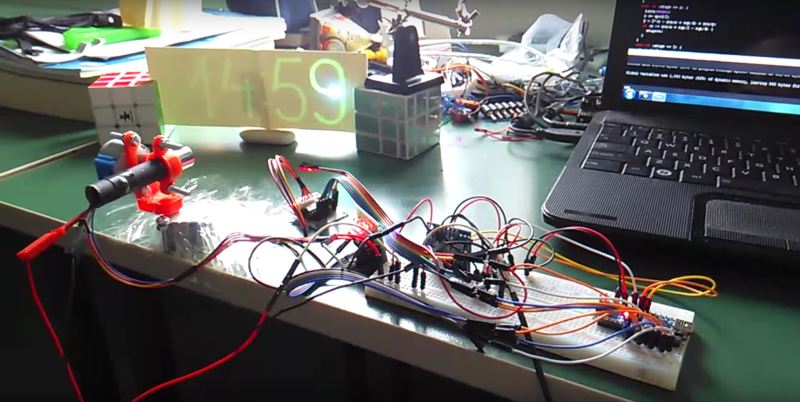Designing a unique clock to flex your technical skills can be a rewarding experience and result in an admirable showpiece for your home. [Andres Robam] saw an opportunity to make a laser-pointer clock that draws the current time onto a glow-in-the-dark sticker.
A pair of stepper motors tilt and pan the laser’s mount — designed in SolidWorks and 3D printed. There was an issue with the motor’s shaft having some slack in it — enough to affect the accuracy of the laser. [Andres] cleverly solved the issue by using a pen’s spring to generate enough tension in the system, correcting it. A NODEmcu v2 is the brains of the clock — chosen because of its built-in WiFi capacity and compatibility with the Arduino IDE — and a 5mW laser sketches the time onto the sticker.
The time is pulled from a web server that [Andres] coded and posted to GitHub if you think you want to build something like this for yourself. Or, you can opt for a clock that floats instead of one with a laser.

















I was just about all clock projected out, but this one is somewhat novel… Bet you could do it with one of those old high persistence mono green screens too. (That can be electronically dead)
A long persistence screen from a SEM would be ideal.
Matt Richardson did a tweet display called Fadeaway, using very similar methods about 4 or 5 years ago, I bet he would have like being able to use a NODEmcu to do it. Unfortunately he doesn’t seem to have gotten around to doing version 2.
I like this new project because those parts are now very cheap and you could fabricate the 3D printed part easily enough using other methods.
Another way to do it is with a row of UV LEDs writing onto the bottom of a rotating cylinder so that the new time comes into view from the bottom. Then your letters fade top to bottom rather than left to right, which may help legibility a bit.
Or one laser diode and a spinning polygon mirror from a laser printer. Timing is going to be much more critical though.
I tried something similar a while back.. Using a servo and a column of 8 LEDs mounted in a 3D printed cylinder. Blue or near-uv LEDs were the only ones able to excite the GITD material significantly. Red, Green or white did nothing at all.
I sourced some blue leds out of a discarded dmx light fixture, but they kept dying on me because i kept overpowering them.
The main problem was that -or- the material got saturated and it became impossible to excite it more, -or- the effect was so short that there was no persistence. I didn’t get to find the sweet spot before running out of LEDs to scavenge..
let me see if i can find a picture ..
ok, so it was 5 LEDs, not 8, couldn’t find pics of it in action, but you get the idea..
http://thygate.com/misc/gitd_clock.jpg
For a more visible display in brighter (but low UV) environments, the luminous material could be substituted with a photochromic material to give a purple/blue on black display.